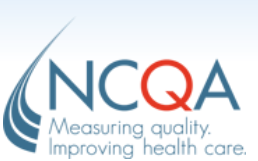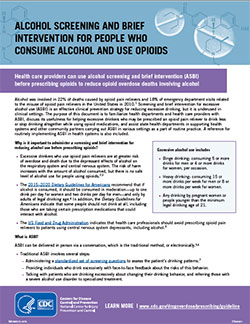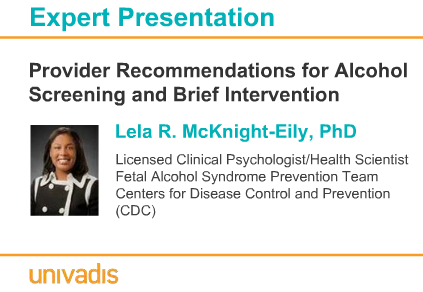CDC’s Alcohol Screening and Brief Intervention Efforts
Alcohol Screening and Brief Intervention (SBI) is Effective at Reducing Excessive Drinking
What Is Alcohol SBI?
Alcohol SBI is a preventive service, like blood pressure or cholesterol screening, which can occur as part of a patient’s wellness visit. It identifies and helps individuals who are drinking more than the recommended amounts. Alcohol SBI involves
- A validated set of screening questions, which only take a few minutes to complete, to identify patients’ drinking patterns; and
- A short conversation with patients who are drinking more than the recommended amounts, as well as referral to treatment when appropriate.
CDC is working to make alcohol SBI a routine part of health care in primary care settings.
Why is Alcohol SBI Important?
Excessive Alcohol Use* is Common
Binge Drinking*: More than 37 million American adults binge drink.1
Heavy Drinking*: In 2013, according to the Behavioral Risk Factor Surveillance System survey, about 6% of the adult population reported heavy drinking.2
Pregnant Women*: During 2015–2017, 1 in 9 (11.5%) pregnant women aged 18–44 years in the United States reported drinking alcohol in the past 30 days. Among pregnant women who reported consuming alcohol, one-third engaged in binge drinking.3
Youth Younger Than 21 Years of Age*: In 2017, 60.4% of high school students reported having at least one drink of alcohol, on at least one day during their life (i.e. ever drank alcohol).4
*Excessive alcohol use includes binge drinking (five or more drinks for men and four or more drinks for women within a 2-hour time period), heavy drinking (more than 14 drinks a week for men and more than seven a week for women), and any alcohol consumption by pregnant women or people younger than 21 years of age.11
Excessive Alcohol Use Leads to Widespread Harm
Alcohol & Pregnancy: Drinking any amount of alcohol during pregnancy can cause a range of physical, behavioral, and learning problems in the baby, called fetal alcohol spectrum disorders (FASDs).5 Additionally, drinking during pregnancy is a risk factor for other poor pregnancy outcomes, such as miscarriage and stillbirth.6
Health & Social Harm: Excessive alcohol use contributes to a wide range of negative health and social consequences, including motor vehicle crashes and intimate partner violence; over time, it can result in serious medical conditions, such as high blood pressure, digestive problems, liver disease, and various cancers.
Costly & Fatal: In 2010, excessive alcohol use cost the United States about $249 billion,7 accounting for an estimated 88,000 deaths per year from 2006 to 2010.1
Effective Clinical Interventions are Available
Alcohol SBI Works: More than 30 years of research has shown that alcohol SBI is effective at reducing excessive alcohol use. Based on this evidence, the U.S. Preventive Services Task Force,8 as well as many other organizations, have recommended that alcohol SBI be implemented for all adults being seen in primary healthcare settings.
In 2012, the Community Preventive Services Task Force recommended the use of alcohol electronic SBIexternal icon (eSBI).9
About CDC’s Alcohol SBI Activities
CDC’s alcohol SBI initiative includes efforts to support alcohol SBI implementation in medical and other settings, improve tracking of alcohol SBI implementation, and identify and partner with healthcare providers, health systems, and health plans to develop and implement system-level strategies that foster alcohol SBI implementation.
Putting Alcohol SBI into Practice
CDC Developed
- Alcohol SBI Implementation Guide pdf icon[2 MB, 52 Pages, Print Only]: This Guide provides the process and resources necessary to help staff in any primary healthcare setting plan and implement alcohol SBI, an evidence-based approach recommended for all adults, including pregnant women. The Guide also provides information on risky alcohol use and how it can be addressed through alcohol SBI.
- Planning and Implementing Screening and Brief Intervention for Risky Alcohol Use: A Step-by-Step Guide for Tribal Communitiespdf icon [2 MB, 62 Pages, 508]: This Guide was adapted from Planning and Implementing Screening and Brief Intervention for Risky Alcohol Use: A Step-by-Step Guide for Primary Care Practices to improve cultural relevance for American-Indian/Alaska-Native communities.
- FASD Prevention Resources: Materials and online trainings have been developed by the American College of Obstetricians and Gynecologists (ACOG) which can be used in OB/GYN settings.
CDC Funded
- Improving Quality of Care through Alcohol SBI and Its Reporting in Electronic Clinical Data Systems: CDC and the Substance Abuse and Mental Health Services Administration (SAMHSA)external icon are working with the National Committee for Quality Assurance (NCQA)external icon to promote a Healthcare Effectiveness Data and Information Set (HEDIS) performance measure, Unhealthy Alcohol Use Screening and Follow-Upexternal icon, or ASF, through a quality improvement learning collaborative with participating health plans. This resulted in the Screening and Follow-Up for Unhealthy Alcohol Use: Quality Improvement Change Package for Health Planspdf iconexternal icon toolkit. This toolkit is designed to help health plans address unhealthy alcohol use among their members and includes examples of effective quality improvement tools, including strategies and best practices for improving HEDIS measure performance. Alcohol SBI is recommended in primary care settings for all adults aged 18 years and older, including pregnant women.
- Implementing Alcohol SBI in Healthcare Systems Providing Women’s Health Services: To prevent alcohol use in pregnancy, CDC, in 2018, funded organizations providing health services to women. These awardees are focusing on development, implementation, and evaluation of alcohol SBI protocols in primary care clinics, facilitation of system-level approaches, such as integration of electronic health records, and sharing of lessons learned.
- Studying Data: CDC is working to better understand provider behaviors by
- Analyzing data from national surveys such as the Behavioral Risk Factor Surveillance System, the National Ambulatory Medical Care Survey, and the Pregnancy Risk Assessment Monitoring System.
- Utilizing health marketing surveys (e.g., ConsumerStyles, DocStyles) to obtain data on provider behaviors.
Strengthening Partnerships to Improve System-level Strategies
- CDC is collaborating with medical and professional organizations, academic institutions, non-profit groups, health plans, and other federal agencies to inform strategies that impede or support implementation of alcohol SBI in primary care settings.
Resources for Obstetrician-Gynecologists
- FASD Prevention Resourcesexternal icon: Materials and online trainings that have been developed by the American College of Obstetricians and Gynecologists (ACOG) for use in OB/GYN settings.
Resources for Youth
While more research is needed to develop effective brief intervention strategies for adolescents,8 the American Academy of Pediatrics (AAP) recommends that pediatricians include substance use screening and appropriate intervention practices in their clinical care for adolescents.10 The following resources are available:
- Pediatric SBI Implementation Guidepdf iconexternal icon: AAP has developed the Substance Use Screening and Intervention Implementation Guide: No Amount of Substance Use is Safe for Adolescents to help incorporate screening, brief intervention, and referral to treatment for use of alcohol, tobacco, marijuana, and other drugs among adolescent patients.
- Adolescent Screening and Substance Useexternal icon: In the article Adolescent Screening, Brief Intervention, and Referral to Treatment for Substance Use: An Application for School Social Workers school social workers are encouraged to incorporate adolescent screening, brief intervention, and referral to treatment for substance use. Highlights are drawn from the Pediatric SBI Implementation Guide listed above.
HEDIS Measure: Unhealthy Alcohol Use Screening and Follow-Up
Screening and Follow-Up for Unhealthy Alcohol Use: Quality Improvement Change Package for Health Planspdf iconexternal icon
NCQA Blog & Podcast:external icon “Inside Health Care: Are Doctors Asking Patients, ‘How Much Do You Drink?’”
NCQA Blog:external icon“Alcohol Screening: What We Know, What We’ve Done and What We (and Plans) Can Do”
Alcohol SBI for People Who
Consume Alcohol and Use Opioids
Read More > pdf icon[869 KB, 4 Pages, Print Only]
Additional Clinical Tools: Opioids >
Collaboration to Promote Alcohol Screening and Brief Intervention

QuantiaMD + Univadis Presentation
References
- Stahre M, Roeber J, Kanny D, Brewer RD, Zhang X. Contribution of excessive alcohol consumption to deaths and years of potential life lost in the United States. Prev Chronic Dis. 2014;11:E109.
- Centers for Disease Control and Prevention. “Data and Maps” Alcohol and Public Health, CDC. https://www.cdc.gov/alcohol/data-stats.htm, March 27, 2018.
- Denny CH, Acero CS, Naimi TS, Kim SY. Consumption of Alcohol Beverages and Binge Drinking among Pregnant Women Aged 18–44 Years — United States, 2015–2017. MMWR Morb Mortal Wkly Rep 2019: April 26, 2019; 68(16): 365-368.
- Youth Risk Behavior Surveillance – United States, 2017pdf icon Morb Mortal Wkly Rep Surveil Summ 2018; 67 (No. SS: 1-479).
- Riley EP, McGee CL. Fetal alcohol spectrum disorders: An overview with emphasis on changes in brain and behavior. Exp Biol Med (Maywood). 2005;230:357–365.
- Bailey BA, Sokol RJ. Prenatal alcohol exposure and miscarriage, stillbirth, preterm delivery, and sudden infant death syndrome. Alcohol Res Health. 2011;34(1):86–91.
- Sacks JJ, Gonzales KR, Bouchery EE, Tomedi LE, Brewer RD. 2010 national and state costs of excessive alcohol consumptionexternal icon. Am J Prev Med. 2015;49:e73–e79.
- US Preventive Services Task Force, Curry SJ, Krist AH, Owens DK, Barry MJ, Caughey AB, Davidson KW, Doubeni CA, Epling JW Jr, Kemper AR, Kubik M, Landefeld CS, Mangione CM, Silverstein M, Simon MA, Tseng CW, Wong JB. Screening and behavioral counseling interventions to reduce unhealthy alcohol use in adolescents and adults: US Preventive Services Task Force recommendation statement.external icon JAMA. 2018;320(18):1899-1909.
- Tansil KA, Esser MB, Sandhu P, et al. Alcohol electronic screening and brief intervention: A Community Guide systematic review. Am J Prev Med. 2016;51(5):801–11.
- American Academy of Pediatrics, Committee on Substance Use and Prevention. 2016 Substance use screening, brief intervention, and referral to treatment [Policy statement]external icon. Pediatrics, 138, 1-3.
- U.S. Department of Health and Human Services and U.S. Department of Agriculture. 2015 – 2020 Dietary Guidelines for Americansexternal icon. 8th Edition. December 2015.




